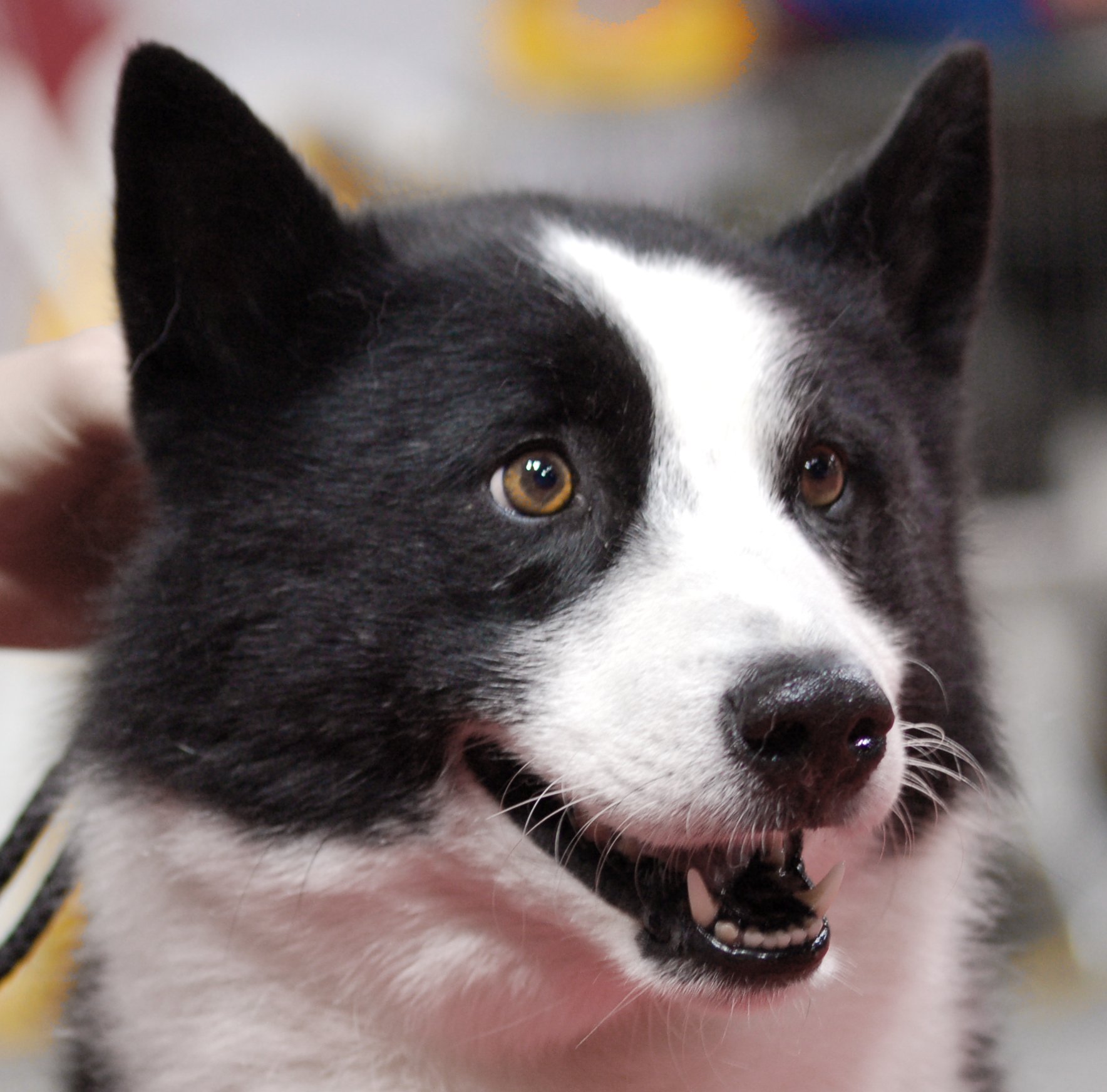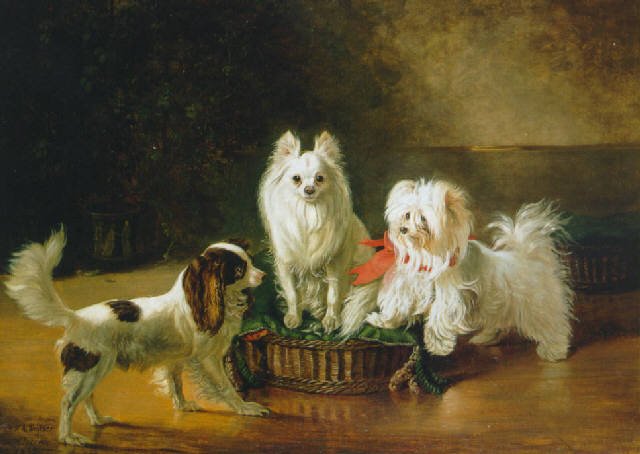|
Spitz Breeds
Spitz (derived from the German word ''spitz'' 'pointed') is a type of domestic dog characterized by long, thick, and often white fur, and pointed ears and muzzles. The tail often curls over the dog's back or droops. While all of the breeds resemble primitive dogs, smaller breeds resemble foxes, while larger breeds resemble jackals, coyotes, wolves The wolf (''Canis lupus''; : wolves), also known as the gray wolf or grey wolf, is a large canine native to Eurasia and North America. More than thirty subspecies of ''Canis lupus'' have been recognized, and gray wolves, as popularly un ..., and even dingoes. The exact origins of spitz dogs are not known, though most of the spitzes seen today originate from the Arctic region or Siberia. The type was described as ''Canis pomeranus'' by Johann Friedrich Gmelin in his revision of ''Systema Naturae'' in 1788. Characteristics Spitzes are well suited to living in harsh northern climates. They often have an Thermal insulation, ... [...More Info...] [...Related Items...] OR: [Wikipedia] [Google] [Baidu] |
Karelian Bear Dog
The Karelian Bear Dog ( Karjalankarhukoira) is a Finnish breed of dog. In its home country, it is seen by many as a national treasure. Karelian Bear Dogs will hunt a variety of animals. Its quick reflexes and fearless nature have made it very popular for hunting large game including brown bears, moose, and wild boar. It was the breed's ability to hunt bears that earned the breed its name. The Karelian Bear Dog is among the top 10 most common dog breeds in Finland. History The Karelian Bear Dog originated from the Komi dog. Basic stock dogs originated from the Ladoga Karelia, Olonets Karelia, and East Karelia where they were used for hunting. The breeding was started in 1936 to create a sturdy dog which would bark at big game, and named the Karelian Bear Dog. The first standard was established in 1945 and the first dogs were registered in 1946. The Karelian Bear Dog was used mainly for hunting small fur-bearing animals, such as squirrels and marten. Like the Norwegian Elkhound, t ... [...More Info...] [...Related Items...] OR: [Wikipedia] [Google] [Baidu] |
Volpino Italiano
The Volpino Italiano or Volpino is an Italian breed of dog of Spitz type. It is closely related to the Pomeranian and to the German Spitz. History Small Spitz-type dogs resembling the modern Volpino have been identified in a number of paintings, of which the earliest may be ''St. Augustine in His Study'' by Vittore Carpaccio, painted in the Scuola di San Giorgio degli Schiavoni in Venice in 1502. The Florentine sculptor Michelangelo supposedly had such a dog. In the eighteenth and nineteenth centuries this type of dog was common in Tuscany, where it was known as the Cane di Firenze and was used as a guard dog by carters and shepherds, and in Lazio, where it was called the Cane del Quirinale. Queen Victoria of the United Kingdom visited Florence in 1888, and bought four dogs of Pomeranian or Spitz type. The first standard for the Volpino Italiano was drawn up by the Kennel Club Italiano in 1913, and the dogs were shown with some success. It was fully accepted by ... [...More Info...] [...Related Items...] OR: [Wikipedia] [Google] [Baidu] |
Alaskan Klee Kai
The Alaskan Klee Kai is a spitz-type breed of dog, developed in the late 20th century as a companion-sized dog resembling the larger Alaskan Malamute and Siberian Husky. It is an energetic, intelligent dog with an appearance that reflects its northern heritage. Bred in three sizes, its weight range is from 5 to 22 pounds as an adult, depending on whether its a standard, toy, or miniature. History The name Klee Kai comes from the Athabaskan words meaning “little dog”. The breed was originally developed in Alaska by Linda Spurlin in the 1970s. The breed was created using the Alaskan Husky, a small amount of Siberian Husky, a slightly larger amount of American Eskimo Dog, and some Schipperkes. Spurlin’s “hardcore approach” to breeding might be considered harsh to some, as she “used the best and culled the rest” in order to create the breed. Description The average Alaskan Klee Kai's temperament is curious, agile, aloof, and intelligent. They can be so intelligent th ... [...More Info...] [...Related Items...] OR: [Wikipedia] [Google] [Baidu] |
American Eskimo Dog
The American Eskimo Dog is a breed of companion dog, originating in Germany. The American Eskimo Dog is a member of the Spitz family. It is considered an ancient dog breed due to its recent admixture with wolves. The breed's progenitors were German Spitz, but due to anti-German sentiment during the First World War, it was renamed "American Eskimo Dog." Although modern American Eskimo Dogs have been exported as German Spitz Gross (or Mittel, depending on the dog's height), the breeds have diverged and the standards are significantly different. In addition to serving as a watchdog and companion, the American Eskimo Dog also achieved a high degree of popularity in the United States in the 1930s and 1940s as a circus performer. There are three size varieties of the American Eskimo Dog breed, the toy, the miniature and the standard. They share a common resemblance with Japanese Spitz, Danish Spitz, Volpino Italiano, German Spitz, Indian Spitz, and Samoyeds. History In Northern Europ ... [...More Info...] [...Related Items...] OR: [Wikipedia] [Google] [Baidu] |
Wolfspitz
The Keeshond ( , plur. Keeshonden) is a medium-sized dog with a plush, two-layer coat of silver and black fur with a ruff and a curled tail. It originated in Holland, and its closest relatives are the German spitzes such as the ''Großspitz'' (Large Spitz), ''Mittelspitz'' (Medium Spitz), ''Kleinspitz'' (Miniature Spitz), ''Zwergspitz'' (Dwarf-Spitz) or Pomeranian. The Keeshond was previously known as the Dutch Barge Dog, as it was frequently seen on barges traveling the canals and rivers of the Netherlands. The Keeshond was the symbol of the Patriot faction in the Netherlands during political unrest in the years immediately preceding the French Revolution. In the late 19th century, the breed was developed in England from imports obtained in both the Netherlands and Germany. In 1930, the Keeshond was first registered with the American Kennel Club. Description Appearance A member of the spitz group of dogs, the Keeshond in American Kennel Club (AKC) standard is to t ... [...More Info...] [...Related Items...] OR: [Wikipedia] [Google] [Baidu] |
Keeshond
The Keeshond ( , plur. Keeshonden) is a medium-sized dog with a plush, two-layer coat of silver and black fur with a ruff and a curled tail. It originated in Holland, and its closest relatives are the German spitzes such as the ''Großspitz'' (Large Spitz), ''Mittelspitz'' (Medium Spitz), ''Kleinspitz'' (Miniature Spitz), ''Zwergspitz'' (Dwarf-Spitz) or Pomeranian. The Keeshond was previously known as the Dutch Barge Dog, as it was frequently seen on barges traveling the canals and rivers of the Netherlands. The Keeshond was the symbol of the Patriot faction in the Netherlands during political unrest in the years immediately preceding the French Revolution. In the late 19th century, the breed was developed in England from imports obtained in both the Netherlands and Germany. In 1930, the Keeshond was first registered with the American Kennel Club. Description Appearance A member of the spitz group of dogs, the Keeshond in American Kennel Club (AKC) standard is to t ... [...More Info...] [...Related Items...] OR: [Wikipedia] [Google] [Baidu] |
Pomeranian (dog)
The Pomeranian (often known as a Pom) is a breed of dog of the Spitz type that is named for the Pomerania region in north-west Poland and north-east Germany in Central Europe. Classed as a toy dog breed because of its small size, the Pomeranian is descended from larger Spitz-type dogs, specifically the German Spitz. It has been determined by the Fédération Cynologique Internationale to be part of the German Spitz breed; and in many countries, they are known as the Zwergspitz ("Dwarf Spitz"). The breed has been made popular by a number of royal owners since the 18th century. Queen Victoria owned a particularly small Pomeranian and consequently, the smaller variety became universally popular. During Queen Victoria's lifetime alone, the size of the breed decreased by half. Overall, the Pomeranian is a sturdy, healthy dog. The most common health issues are luxating patella and tracheal collapse. More rarely, the breed can have Alopecia X, a skin condition colloquially known as ... [...More Info...] [...Related Items...] OR: [Wikipedia] [Google] [Baidu] |
Lap Dogs
A lap dog or lapdog is a dog that is both small enough to be held in the arms or lie comfortably on a person's lap and temperamentally predisposed to doing so. ''Lapdog'' is not a specific breed, but a generic term for a Dog type, type of dog that is small in size and friendly towards humans. Lap dogs historically have been kept in many societies around the world by individuals with the resources to support a non-productive animal, and a lifestyle which allows for much contact with the dog. They are docile Companion dog, companion animals with no working function other than companionship. Genetic analysis reveals that lapdogs are among the earliest specific types of dogs to live with people. Today, most lapdog breeds fall into the Toy group, ''toy'' Breed Groups (dog), breed group. Additionally, the term "lapdog" is also used to refer to a person, organization or country controlled by another who is stronger. Appearance Some lapdogs have been bred for extremes of small size, s ... [...More Info...] [...Related Items...] OR: [Wikipedia] [Google] [Baidu] |
Laika (dog Type)
Laikas ( rus, Ла́йка, p=ˈlajkə) are aboriginal spitz from Northern Russia, especially Siberia but also sometimes expanded to include Nordic hunting breeds. Laika breeds are primitive dogs who flourish with minimal care even in hostile weather. Generally, laika breeds are expected to be versatile hunting dogs, capable of hunting game of a variety of sizes by treeing small game, pointing and baying larger game and working as teams to corner bear and boar. However a few laikas have specialized as herding or sled dogs. Definition The Russian word () is a noun derived from the verb (, to bark), and literally means ''barker''. As the name of a dog variety, it is used not only in Russian cynological literature, but sometimes in other languages as well to refer to all varieties of hunting dogs traditionally kept by the peoples of the northern Russia and adjacent areas. This includes not only the three or four breeds known as Laikas in English, but also other standard breeds t ... [...More Info...] [...Related Items...] OR: [Wikipedia] [Google] [Baidu] |
Huskies
Husky is a general term for a dog used in the polar regions, primarily and specifically for work as sled dogs. It refers to a traditional northern type, notable for its cold-weather tolerance and overall hardiness. Modern racing huskies that maintain arctic breed traits (also known as Alaskan huskies) represent an ever-changing crossbreed of the fastest dogs. Huskies have continued to be used in sled-dog racing, as well as expedition and trek style tour businesses, and as a means of essential transportation in rural communities. Huskies are also kept as pets, and groups work to find new pet homes for retired racing and adventure-trekking dogs. History Nearly all dogs' genetic closeness to the gray wolf is due to admixture. However, several Arctic breeds also show a genetic closeness with the now-extinct Taimyr wolf of North Asia due to admixture: the Siberian Husky and Greenland Dog (which are also historically associated with Arctic human populations) and to a lesser ext ... [...More Info...] [...Related Items...] OR: [Wikipedia] [Google] [Baidu] |







